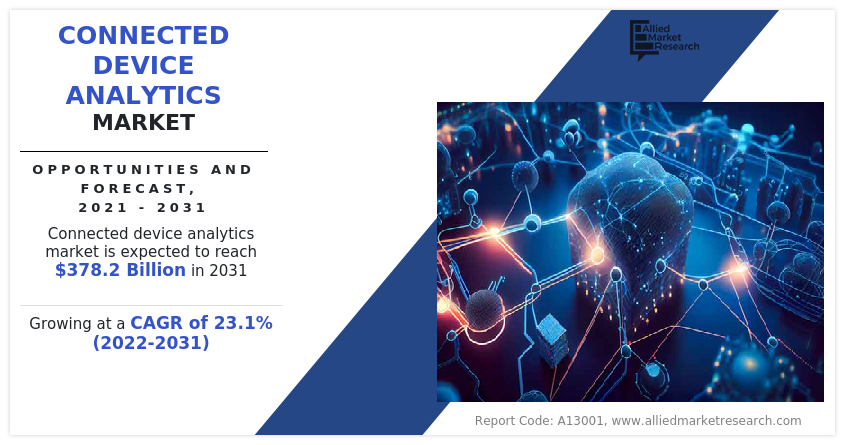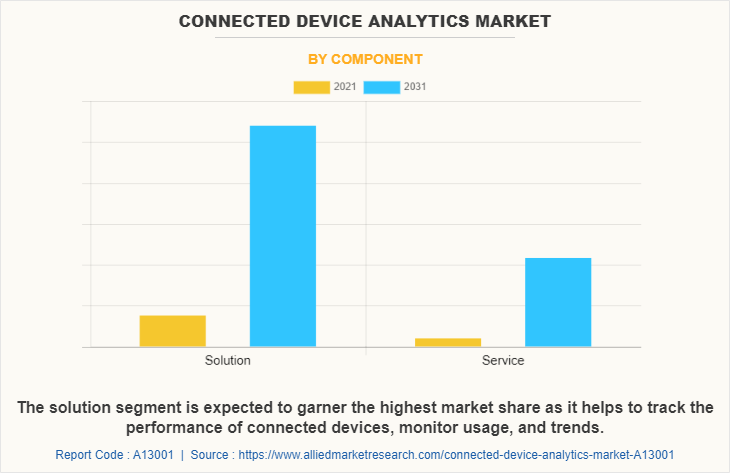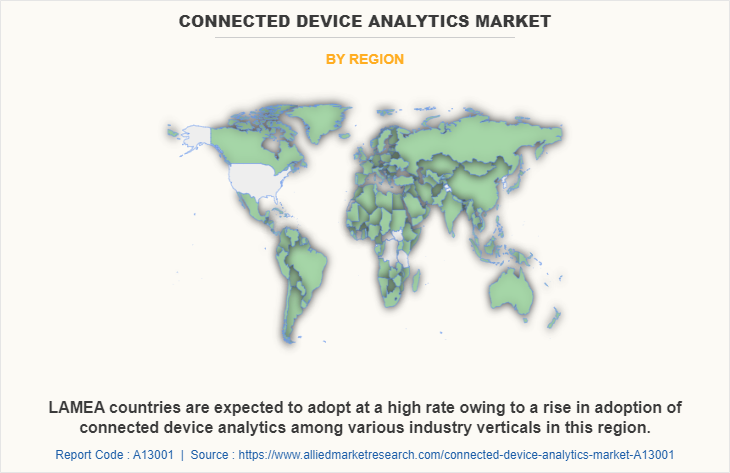Connected Device Analytics Market Statistics, 2031
The global connected device analytics market was valued at $48.2 billion in 2021, and is projected to reach $378.2 billion by 2031, growing at a CAGR of 23.1% from 2022 to 2031.
Increase in focus on remote monitoring in support of work-from-home initiatives and an increase in penetration of the internet and IoT devices boosts the growth of the global connected device analytics market. In addition, increase in use of digital transformation technology positively impacts growth of the connected device analytics market. However, lack of a skilled workforce and increase in security concerns hampers the connected device analytics market growth. On the contrary, increase in real-time analytics emerging as a key vital IoT initiative is expected to offer remunerative opportunities for expansion of the connected device analytics market during the forecast period.

Connected device analytics is a cloud-based platform that is used to enhance the customer communications platform by delivering connectivity between applications, people, and objects. Connected device analytics leads the way to enhance the new age of connectivity. The delivery model enables the addition of messaging features, voice, and video to the existing business software with the integration of APIs. Connected device analytics is deployed by business enterprises that look to include communication in their business applications.
Segment Review
The connected device analytics market is segmented on the basis of component, deployment mode, enterprise size, application, industry vertical, and region. On the basis of component, the market is bifurcated into solution and service. On the basis of deployment mode, the market is bifurcated into cloud and on-premise. On the basis of enterprise size, the market is bifurcated into large enterprises and SMEs. On the basis of application, it is segmented into security and emergency management, sales and customer management, remote monitoring, predictive maintenance and asset management, inventory management, energy management, building automation, and others. On the basis of industry vertical, it is classified into manufacturing, transport and logistics, energy and utilities, retail and E-commerce, BFSI, health and life science, government and defense, and others. On the basis of region, the market is studied across North America, Europe, Asia-Pacific, and LAMEA.

On the basis of component, the solution segment holds the highest connected device analytics market share, owing to rapid growth in consumer base across all communication channels. However, the service segment is expected to grow at the highest rate during the forecast period, as it helps to increase organizational efficiency, reduce cost, and enhance customer engagement.

On the basis of region, the connected device analytics market size was dominated by North America in 2021. The region is expected to retain its position during the forecast period, owing to the adoption of advanced technologies for payment, and an increase in the need for digital infrastructure. This is expected to drive the market for connected device analytics technology within the region during the forecast period. Asia-Pacific is also expected to witness significant growth during the forecast period, owing to a rise in demand penetration of the internet and adoption of the Internet of Things (IoT).
The key players that operate in the connected device analytics industry market are Adobe, Cisco Systems Inc., Amazon Web Services Inc., Hitachi Ltd., Google LLC, Teradata Corporation, IBM Corporation, SAP SE, Oracle Corporation, and Microsoft Corporation. These players have adopted various strategies to increase their market penetration and strengthen their position in the Connected device analytics industry.
Top Impacting Factors
Increase in Focus on Remote Monitoring in Support of Work-from-home Initiatives
Remote work monitoring, which includes time tracking, is an important tool in business that drive revenue and productivity. In addition, the adoption of remote monitoring is a commonplace business practice as several organizations embrace the trend of enabling their workforce with the flexibility of working from home. Furthermore, with businesses moving toward developments, the technology demand would boom immensely and the increase in the adoption of technologies such as AI, IoT, and ML would drive business revenue growth.
In addition, remote work enhances teamwork capability of working better work productivity whether it is a permanent move or transitioning to remote work temporarily, thus limiting exposure to COVID-19. Moreover, verticals such as manufacturing, energy and utilities, aviation, and logistics, are facing challenges in managing asset tracking and maintaining reduced costs. The adoption of remote monitoring along booming technologies such as IoT, to collect new and additional operational data and enable improved asset management through deeper data analysis would increase growth of the companies.
Increase in Use of Digital Transformation Technology
Digitization is the process of converting data or information into a digital format with the adoption of advanced technology. It plays very important role in the financial sector owing to the growing need among financial consulting providers for providing enhanced customer services and to improve the security of the customer. Furthermore, SaaS also helps companies to offer digital services to their customers and saves time on financial consulting, which propels the growth of the connected device analyticsmarket. In addition, rise in demand for digital transformation technology in the industry vertical and growth in dependency of various banks on SaaS solutions drives the growth of the connected device analytics market.
In addition, connected device analytics market players across the globe are adopting various advanced technology such as blockchain technology, big data, and artificial intelligence to increase productivity with minimal resource utilized which drives the growth of the connected device analytics market. For instance, in November 2022, Ericsson Internet of Things partnered with Thales to launch enables enterprises to now order eSIMs while selecting preferred communications service providers at the time of device activation, making IoT easier than ever before, such initiative helps to drive the market growth
Key Benefits:
The communications platform as a service market experiences tremendous growth owing to the rise in users of mobile and smartphones across the globe. Connected device analytics also supports to take smart decisions and offers the most efficient processes that are helpful for growth of the business. These tools also offer a considerable benefit to the business by augmenting their decision-making and improving safety and security by monitoring real-time data.
Moreover, it will benefit by providing additional operational data and improving asset management and data analysis thereby boosting the business growth. This allows small and large companies to manage, analyze, and predict the operations and processes of the business. These tools are also helpful in improving profitability, and efficiency, and also neutralizing the threats in the business. Moreover, Organizations like industrial, enterprise sectors, and across consumers, are speedily assessing and applying for programs so as to realize their instant value and concentrate on cost reduction, and monitoring to collect real-time services which are needed for timely decision-making.
End-user Adoption:
Major market players have started partnering with companies to expand their market penetration and reach with an increase in competition. For instance, in August 2022, Amazon partnered with Civica on fresh insight into connected devices and helps in addressing the likes of environmental sustainability, improved health care, vulnerable citizen support, and enhanced public safety.
Various companies have expanded their current product portfolios and innovations with increased diversification among customers due to technological advancements across the world and the rise in demand for Connected device analytics. For instance, in June 2020, PTC launched the latest version of its market-leading ThingWorx industrial IoT platform. ThingWorx 9.0 is projected to deliver new and expanded features to help industrial companies create, implement, customize, and scale their solutions. Moreover, ThingWorx was the first platform that focused exclusively on the industrial market for digital transformation use cases.
For instance, in June 2020, PTC extended an alliance with Rockwell Automation to launch factory insights as a service offering for industrial enterprises. This enables customers to save time and money by reducing the complexity that they typically undertake as part of industrial internet of things (IIoT) implementation and greater digital transformation efforts. Factory insights as a service is a perfect on-ramp for manufacturers interested in improving their operations by providing valuable intelligence and insights on operational performance, asset utilization, and workforce efficiency.
Moreover, with an increase in competition, major connected device analytics market players have started acquiring companies to expand their market penetration and reach. For instance, in June 2020, Microsoft acquires CyberX to accelerate and secure IoT deployments of customers. IoT provides real-time insights into assets, enabling businesses to reduce operational expenses, unplanned downtime, and unnecessary servicing.
Government Regulations:
All well-governed industries should be able to demonstrate due diligence to ensure regulatory compliance in applicable fields, including IT. Organizations are increasing the adoption of advance electronics heavily influenced by COVID-19. In addition, federal and state governments are improving their track plans for various privacy laws, which are applicable to data that are involved in their operations. For instance, in February 2022 the European Union proposed an interesting addition to its fast-updating digital rulebook the Data Act will address “the legal, economic and technical issues that lead to data being under-used.
For instance, in March 2022, the U.S. and European Commission announced the new Trans-Atlantic Data Privacy Framework to put in place new safeguards to ensure that signals surveillance activities are necessary and proportionate in the pursuit of defined national security objectives. Furthermore, the GDPR Act imposed by the European Government mitigates the risk of cyber security and any potential data breaches. Emerging countries of Asia-Pacific develop stringent regulations, which comprise privacy, government regulatory environment, and intellectual property protection.
Key Benefits for Stakeholders
The study provides an in-depth analysis of the connected device analytics market forecast along with current trends and future estimations to explain the imminent investment pockets.
Information about key drivers, restraints, and opportunities and their impact analysis on the connected device analytics market trends is provided in the report.
Porter’s five forces analysis illustrates the potency of the buyers and suppliers operating in the industry.
The connected device analytics market analysis from 2022 to 2031 is provided to determine the market potential.
Connected Device Analytics Market Report Highlights
| Aspects | Details |
| Market Size By 2031 | USD 378.2 billion |
| Growth Rate | CAGR of 23.1% |
| Forecast period | 2021 - 2031 |
| Report Pages | 264 |
| By Component |
|
| By Enterprise Size |
|
| By Deployment Model |
|
| By Application |
|
| By Industry Vertical |
|
| By Region |
|
| Key Market Players | Cisco Systems Inc., Oracle Corporation, Hitachi Ltd., Teradata Corporation, Adobe, Microsoft Corporation, IBM Corporation, SAP SE, Google LLC, Amazon Web Services Inc. |
Analyst Review
Connected devices are the physical appliances that interconnect with the help of the internet. It connects systems like desktop computers and laptops to mobile devices like tablets or smartphones. In addition, the list is growing to fitness & health trackers, vehicles, cooling & heating devices, home appliances, environmental sensors, and several others. These devices integrate with advanced technology for collecting data, processing chips, and sharing them with other devices. Connected devices are controlled and monitored remotely. It connects with the help of the internet through different wireless and wired networks. The connected device analytics permit organizations to develop services and platforms that help them to effectively evaluate and manage real-time information streams from multiple data sources. It allows companies to protect, manage, and optimize business processes & operations, neutralize threats, improve product profitability, and efficiency.
The global connected device analytics market is expected to register high growth due to rapid centralization and digitization of business processes to streamline all operations into a single platform are expected to drive industry growth. Thus, increase in adoption of connected device analytics, owing to protect, manage, and optimize business processes & operations, neutralize threats, improve product profitability, and efficiency factors driving the growth of the market. With surge in demand for connected device analytics, various companies have established alliances to increase their capabilities. For instance, in December 2022, KORE, a global leader in Internet of Things (IoT) Solutions and worldwide IoT Co partnered with Google LLC to bring IoT capabilities to global businesses help businesses securely provision, manage and scale their IoT devices. Through this new partnership, enterprises get more value from connected devices and equipment and gain real-time insights from their IoT data.
In addition, with further growth in investment across the world and the rise in demand for connected device analytics, various companies have expanded their current product portfolio with increased diversification among customers. For instance, in February 2022, Vodafone launched a new global platform that takes the world of connected devices to the next level by allowing them to securely trade with each other on a user’s behalf.
Moreover, with increase in competition, major market players have started acquisition companies to expand their market penetration and reach. For instance, April 2022, Blackline Safety Corp acquired Ontario-based Swift Labs Inc to enable Blackline to accelerate its pace of innovation by expanding its product development capacity.
The Connected device analytics market is estimated to grow at a CAGR of 23.1% from 2022 to 2031.
The Connected device analytics market is projected to reach $ 378.24 billion by 2031.
Increase in focus on remote monitoring in support of work-from-home initiatives and an increase in penetration of the internet and IoT devices boosts the growth of the global connected device analytics market. In addition, increase in use of digital transformation technology positively impacts growth of the connected device analytics market.
The key players profiled in the report include Adobe, Cisco Systems Inc., Amazon Web Services Inc., Hitachi Ltd., Google LLC, Teradata Corporation, IBM Corporation, SAP SE, Oracle Corporation, and Microsoft Corporation.
The key growth strategies of Connected device analytics market players include product portfolio expansion, mergers & acquisitions, agreements, geographical expansion, and collaborations.
Loading Table Of Content...



